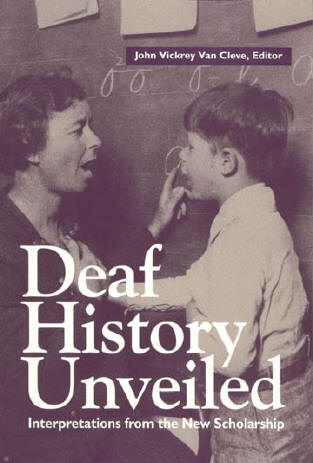John Vickery Van Cleve, ed., Deaf History Unveiled: Interpretations from the New Scholarship, Washington D.C.: Gallaudet University Press, 1993.
 Review
written by Katherine Heim
Review
written by Katherine Heim
submitted:
29 November 2003
Deaf History Unveiled
In his book Deaf History Unveiled: Interpretations from the New Scholarship, John Van Cleve presents a compilation of essays presented at the first International Deaf History Conference, hosted by the Gallaudet University History Department in 1991. As the title suggests, Deaf History Unveiled, delves into several of the frequently encountered myths, legends, and prejudices that have surrounded Deaf cultural and educational history. The essays in the collection cover a broad range of topics, from the earliest documented hand signing "dictionary"1 to the contemporary western medical establishment's view of Deafness as a disability requiring aggressive therapy to "fix" the defect.2 Although many of the essayists are from the United States, the book features seven writings that focus on the evolution of Western European Deaf culture and education, providing a broad selection of perspectives on how Deaf cultural minorities have fared historically. The essays contained within Deaf History Unveiled, provide an in-depth perspective of just a few of the people, events, and educational trends that have influenced contemporary Deaf culture and suggests avenues of additional sociological and historical research.
Three of the essay's, "Abbe de I' Epee and the Living Dictionary," "Deaf-Mute Banquets and the Birth of the Deaf Movement," and " Republicanism, Deaf Identity, and the Career of Henry Gaillard in Late- Nineteenth- Century France," focus on the influence that the historical period known as the "Enlightenment," had in Deaf cultural development and education approaches. Researcher Bernard Mottez theorizes that the earliest Deaf-Mute banquets which took place in Paris during the 1830's were a product of Enlightenment thinking and French Revolutionary ideology from the previous century.3 In response to increased pressure from the dominate hearing community, the educated Deaf "elite" held a banquet in 1834 in celebration of the birthday of Abbe de I'Eppe, who was credited with founding a Deaf school that used sign language as the preferred teaching method,4 and as a political protest against the oralist direction the Paris Institute was then considering. By the close of the nineteenth century, essayist Anne T Quartararo argues, "the French deaf community[‘s] call for social equality in republican France would remain unanswered."5 Deaf education remained available to only the wealthy, it emphasized vocational trade training rather than academic scholarship, and oralists were becoming increasingly influential.
In the United States (U.S.) a similar pattern existed, alternating between a modicum of self determination for Deaf individuals and the dominate hearing world's agenda for the Deaf. In her essay, "Vocational Education in the Deaf American and African-American Communities," Tricia Leakey argues, "Beginning in the nineteenth century…both minority communities institutionalized mass programs of vocational education in efforts to promote community advancement."6 She notes that in the U.S., as was the trend in Europe, an academic education was secondary to useful productivity, even when that productivity was incapable of generating a living wage. In addition to an emphasis on vocational education, during the same period, social Darwinism gained popular favor in the U.S. and American Sign Language (ASL) increasingly came under attack as "associated with a lower stage of evolution."7 Acceptance of social Darwinism created a receptive atmosphere for the oralist objective of intelligible speech as the primary goal of Deaf education and reinforced a disability model rather than recognizing the Deaf minority culture. Robert Buchanan's essay, "The Silent Worker newspaper and the Building of a Deaf Community: 1890-1929," offers a synopsis of the forty-year conflict between the U.S. Deaf community and the hearing agenda for Deaf education. Using primary documents, Buchanan argues that the Silent Worker, a newspaper written by Deaf Americans with an emphasis on issues concerning the Deaf community refuted the popular belief that deafness was a "severe handicap and deaf people [were] somehow deficient,"8 a misconception that remains an issue within the U.S.
In conclusion, the essays compiled by Van Cleve offer multiple interpretations of an established social pattern present in both Western Europe and North America. Public education has been historically designed to teach "to the average" student and the responsibility of obtaining an education for anyone not "average" has fallen to charities and private institutions. While not a disability, the multiple essayists conclude that the dominate hearing culture has "pigeon holed" deafness as such, creating a historically chronically underemployed and undereducated minority Deaf community. Overall, Deaf History Unveiled provided an enlightening overview of Deaf cultural and educational history.
1. John Vickery Van Cleve, ed., Deaf History
Unveiled: Interpretations from the New Scholarship (Washington D.C.:
Gallaudet University Press, 1993), 13.
2. Van Cleve, 272.
3. Van Cleve, 29.
4. Van Cleve, 17.
5. Van Cleve, 50.
6. Van Cleve, 75.
7. Van Cleve, 99.
8. Van Cleve, 173.